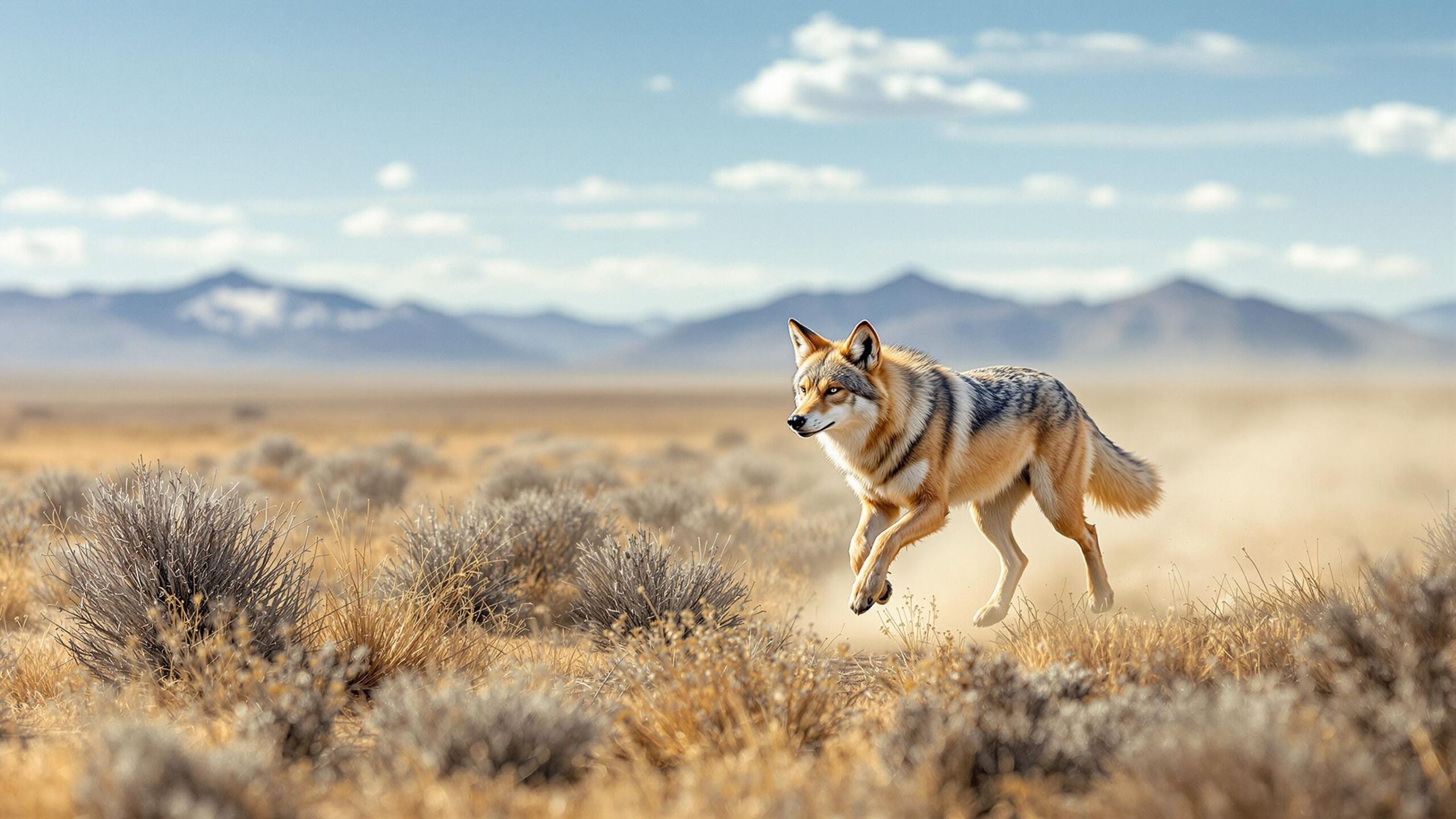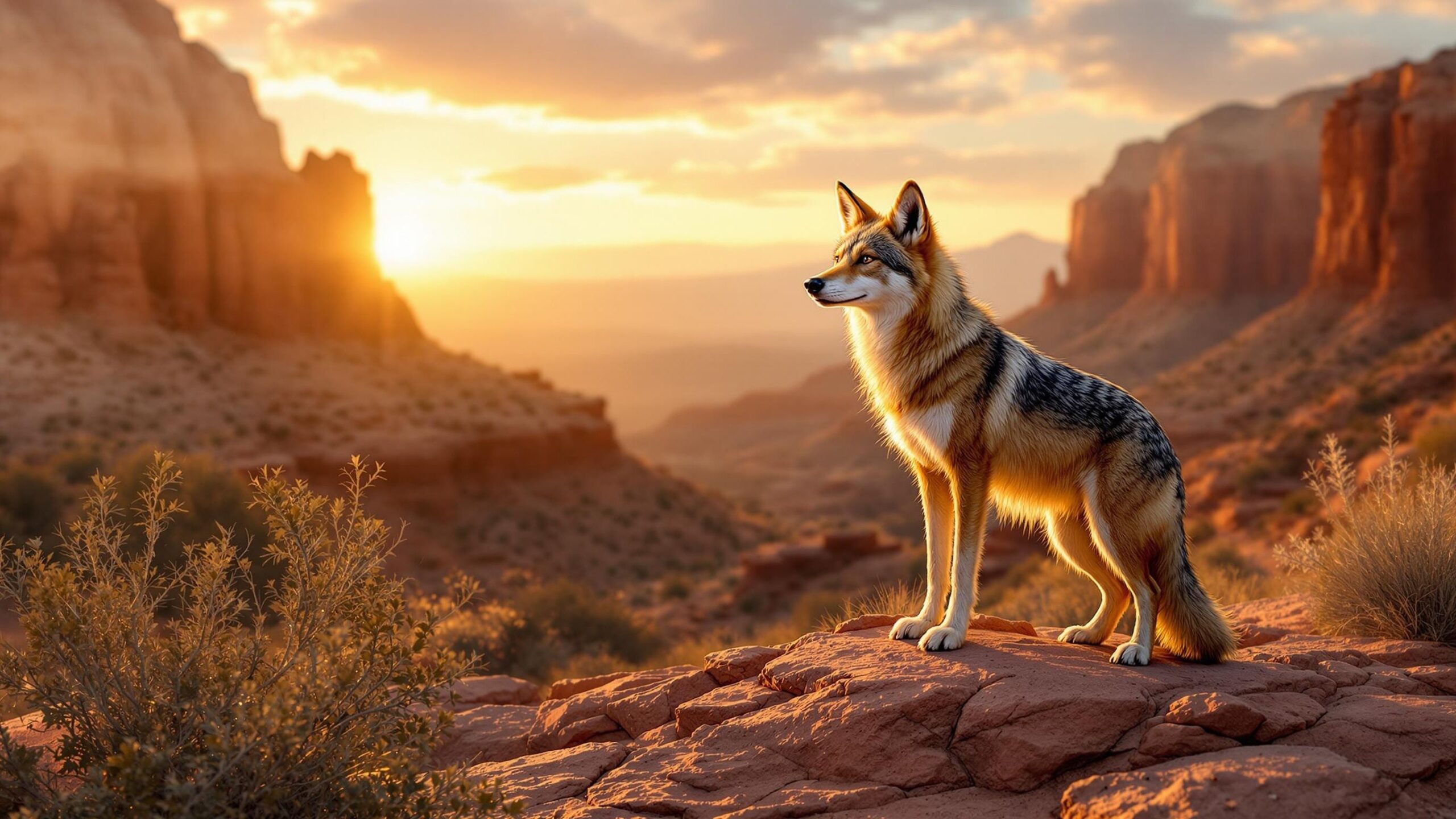Western Coyote: The Adaptive Trickster of the American West
Scientific Name: Canis latrans
Slicing through the stillness of the desert night or echoing from the foothills of a sun-scorched canyon, the unmistakable howls of the Western Coyote signal the presence of one of North America’s most iconic—and misunderstood—creatures. With its keen intelligence, sharp senses, and extraordinary adaptability, the Canis latrans, or Western Coyote, thrives in landscapes where other predators falter. Often referred to as the “song dog” of the West, this resilient canid has played a starring role in Native American folklore and continues to influence modern ecological systems.
The Western Coyote is far more than a scrappy scavenger or rural nuisance. It is a keystone species, a cultural symbol, and one of the most successful wild mammals on the continent. From the mountains of Montana to the deserts of Arizona and beyond, the Western Coyote remains a master of survival, even in the face of habitat loss, human expansion, and intense efforts to control its numbers.
Origins and Taxonomy: The True American Wild Dog
The Western Coyote is a subspecies of Canis latrans, which in Latin means “barking dog.” It belongs to the family Canidae and shares common ancestry with wolves, foxes, and domestic dogs. Fossil records trace coyote lineage back several million years, making it one of the oldest surviving canid species in North America.
Coyotes originally evolved in open grasslands and deserts of the western United States and Mexico. Historically restricted to these areas, the Western Coyote distinguished itself from other subspecies by adapting to arid climates, vast open spaces, and a diet that demanded flexibility and cunning. Over time, the coyote’s range expanded, and as different populations intermingled, regional variations developed. Yet the Western Coyote remains closest in form and behavior to its ancestral roots. Despite sometimes being confused with wolves or even stray dogs, Western Coyotes maintain a distinct identity both genetically and ecologically. They are smaller than wolves but larger than foxes, occupying a unique niche in the food web.
Physical Characteristics: Lean, Swift, and Built to Hunt
The Western Coyote is a medium-sized canid with a lean, athletic frame designed for endurance and speed. Adult coyotes generally weigh between 20 and 35 pounds, though some desert-dwelling individuals can weigh slightly less. They stand around 24 inches tall at the shoulder and measure up to 4.5 feet in total length, including their bushy tail.
Their fur is typically a mottled mix of gray, tan, and reddish-brown, with lighter underparts and darker markings along the back and tail. In colder months, their coat thickens considerably, providing insulation against frigid nighttime temperatures in desert and mountain habitats. Their ears are pointed and erect, allowing them to pick up the faintest sounds of prey rustling in the brush. Coyotes have sharp, intelligent eyes and a long snout that houses a keen sense of smell. Their long legs and slender frame make them agile runners, capable of reaching speeds up to 40 miles per hour in short bursts. This combination of speed, stealth, and stamina makes the Western Coyote a formidable hunter.
Range and Habitat: From Desert Flats to Alpine Heights
Though the coyote’s historic range was confined to the western two-thirds of North America, the Western Coyote itself is primarily found in the western United States and northern Mexico. Its habitats include deserts, grasslands, scrublands, sagebrush country, foothills, and even alpine forests.
One of the coyote’s greatest evolutionary achievements is its ability to thrive in fragmented and harsh environments. In the dry deserts of Arizona and Nevada, it navigates arroyos and hunts at twilight to avoid the heat. In the plains of Colorado and New Mexico, it follows herds of jackrabbits or scours the landscape for carrion. In the high elevations of the Sierra Nevada and Rockies, it preys on marmots and ground-nesting birds. Although urban and suburban coyotes are common in other parts of the country, the Western Coyote tends to avoid dense human populations, sticking to rural and semi-wild areas. Still, they may occasionally appear near ranches, farms, or small desert communities.

Behavior and Intelligence: The Trickster in Action
Western Coyotes are highly intelligent and notoriously difficult to outwit. Their behavior is shaped by survival instincts honed over millennia, making them adaptable, observant, and cautious. They are often solitary but will form pairs during breeding season and may hunt or travel in small family units, especially when food is abundant. Coyotes are crepuscular, meaning they are most active during dawn and dusk. In particularly hot regions, they may also become nocturnal. Their ability to adjust their daily patterns helps them avoid human activity and extreme temperatures.
They use a variety of vocalizations—yips, barks, howls, and growls—to communicate with other coyotes. These calls serve multiple purposes, including territory marking, pack cohesion, and mating signals. The coyote’s “singing” is often mistaken for a larger group than actually exists, thanks to their ability to vary pitch and tone rapidly, creating the illusion of a chorus. Their intelligence is evident in their hunting strategies. Western Coyotes are known to work in pairs to flush out prey, use deceptive tactics to lure animals, and adapt quickly to changes in food sources or threats.
Diet and Hunting: Opportunistic and Efficient
The Western Coyote is an omnivorous predator with a diet as diverse as its habitat. It primarily consumes small to medium-sized mammals such as rabbits, rodents, ground squirrels, and prairie dogs. It also eats reptiles, amphibians, birds, insects, and occasionally larger prey like fawns or livestock, though these instances are rarer and usually draw disproportionate attention.
Coyotes are scavengers as well as hunters. Carrion—especially the remains of deer or cattle—makes up a significant portion of their diet in some regions. They are also known to eat fruit, berries, grasses, and seeds when animal protein is scarce. One of the Western Coyote’s most remarkable traits is its ability to adapt its diet to what’s available. In areas where jackrabbits thrive, coyotes focus almost exclusively on them. In drier regions with little prey, they shift to reptiles or bugs. This dietary flexibility ensures that coyotes can survive seasonal fluctuations and environmental disruptions.
Reproduction and Life Cycle: Life in the Den
Mating season for Western Coyotes typically occurs between January and March. Once a pair forms a bond, they may remain together for several years, sometimes for life. After a gestation period of about 63 days, the female gives birth to a litter of four to seven pups in April or May.
Dens are usually located in sheltered areas such as brush piles, rock crevices, abandoned burrows, or under trees. Both parents participate in raising the pups, bringing food and guarding the den. Pups begin emerging from the den at about three to four weeks of age and are weaned by six to seven weeks. By autumn, most pups begin to disperse and find their own territories, although some may stay with their family group for a while longer. Dispersing juveniles are known to travel significant distances in search of unoccupied habitat, contributing to the species’ range expansion.
Relationships with Other Wildlife: A Balancing Force
The Western Coyote plays a vital ecological role as both predator and prey. As a mid-sized carnivore, it helps regulate populations of rodents, rabbits, and other small mammals, which can have far-reaching effects on vegetation and ecosystem health. This predator-prey dynamic makes the coyote a crucial balancing force in many western habitats.
Coyotes themselves are preyed upon by larger predators, including mountain lions, wolves, and bears, though these interactions are relatively rare due to the coyote’s cunning and evasiveness. Golden eagles and other raptors may also take young pups. In some regions, Western Coyotes compete with bobcats and foxes for food. They often dominate smaller carnivores but avoid direct conflict unless threatened.
Human Interaction: Conflict, Coexistence, and Control
The Western Coyote’s expansion has not been without friction. Livestock predation, particularly on sheep and calves, has led to widespread persecution of coyotes throughout the West. Bounty programs, government-funded eradication campaigns, trapping, and aerial shooting have all been employed to reduce coyote populations.
Despite these efforts, coyotes continue to thrive. In many areas, heavy control measures have proven ineffective in the long term. Coyotes reproduce quickly, fill in population gaps, and adjust their behavior to avoid danger. Some studies suggest that removing dominant coyotes can even increase local birth rates and territorial shifts, making population control a complex challenge.
Today, the conversation around coyote management is evolving. Wildlife biologists and conservationists increasingly promote coexistence strategies, including the use of livestock guardian animals, improved fencing, and non-lethal deterrents. Public education campaigns encourage residents to secure trash, supervise pets, and avoid feeding coyotes—steps that significantly reduce conflicts.
Cultural Significance: The Mythic Trickster
Long before Europeans arrived in North America, the coyote featured prominently in the oral traditions of Native American tribes. Often depicted as a trickster, shapeshifter, or teacher, the coyote was seen as both clever and mischievous—an animal that challenged the rules and taught valuable lessons through its antics.
For the Navajo, Hopi, and many others, the coyote is a spiritual figure, appearing in myths that explain the creation of stars, the origins of death, and the complexities of human behavior. These tales speak to the animal’s deep connection with the land and its people—a connection that continues to this day, albeit now with more scientific lenses. In popular culture, the coyote remains a symbol of wildness, adaptability, and survival against the odds. From the cartoons of Wile E. Coyote to the literary symbolism of desert landscapes, this enduring character occupies a unique space in the human imagination.

Conservation Status: A Survivor, Not a Victim
Unlike many native predators, the Western Coyote is not endangered. In fact, it is one of the few large mammals that has increased its range significantly in the last century. Still, it faces challenges. Habitat fragmentation, rodenticide poisoning, vehicle collisions, and unregulated hunting in some states continue to affect local populations.
However, the coyote’s resilience offers hope. As scientists learn more about the ecological roles of coyotes, attitudes are slowly shifting. Management plans in national parks, rangelands, and suburban green spaces increasingly factor in the benefits of having coyotes in the landscape. Conservation does not necessarily mean protection from all harm—it means informed coexistence. For the Western Coyote, that means finding ways to reduce conflict while recognizing the animal’s right to exist and the value it brings to the ecosystem.
Nature’s Resilient Strategist
The Western Coyote is many things: a predator, a scavenger, a parent, a wanderer, and above all, a survivor. It has endured persecution, habitat loss, and climate extremes, emerging each time more cunning, more resourceful, and more attuned to the rhythms of its changing world.
In its yip and howl is the voice of a land both wild and wounded, and in its eyes shines a quiet, intelligent defiance. Whether bounding across sagebrush flats, trotting silently through the shadowed desert, or perched on a hill beneath a setting sun, the Western Coyote remains a example of the power of adaptation and the enduring spirit of the American West.

